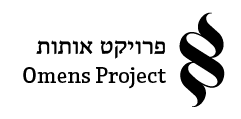The alphabet is by many means the genetic code of our consciousness – in the book of yetzirah it is written that the letters are the building materials of reality itself. Working with these materials is an exciting opportunity for us to create our reality and discover others. We want to invite you to play with the notion that our world is full of tools that sit on the spectrum between “puzzles” and “Lego”. The puzzle tools are more of a one function tool – you can only form a single picture – that was basically broken down originally into pieces of this puzzle. On the other edge of the spectrum we have tools that work more like Lego – these are building blocks that can be combined into infinite combinations. This is the difference between open source tools to closed garden tools.
The Hebrew alphabet is part of a pivotal family of alphabets that were born only a few millennia ago. The first graphic alphabets were “hieroglyphic” sets of symbols – ancient Egypt or the Chinese alphabets for example were actually iconic tool sets – every word had a character – a drawing – a dog meant dog, and a hand meant hand. It was easy to understand, but it was a limited tool – when attempting to express a complex message – the authors would invent many symbols and these alphabets became huge and endless sets of symbols for every concept that existed in a culture – and this created a challenge of distribution and teaching.
Later in history an amazing “phenomenon” appeared in the middle eastern part of the Mediterranean – the ‘phonetic alphabets’ – a graphic set of symbols that had a unique sound that came with every one of them – they were similar to musical notes. The letter ‘pei’ for exaple was a symbol that was not only a word – but a sound that was made with the lips “p”. It was a game changing technology at the time – people could “record” the sound of their voice and transmit it through long distances. On one hand, it was a language that was less universal from a symbolic point of view – think about it – almost every person that sees the Egyptian hieroglyphics can understand something – it is quite intuitive. But try expressing abstract concepts like love, thought, belief, or peace with a hieroglyphic alphabet and it will be a challenge. The phonetic alphabet had opened a whole new world of communicative and expressive opportunities that were not accessible before. The phonetics brought a mysterious and spiritual wave into the world. Some perceive it as an artificial intelligence of sorts – a set of codes and ideas that seem to have a consciousness or its own – language seems to be alive at times.
Following this line of thought, the phonetic alphabets work more like Lego than a puzzle. With phonetics i can easily name something that has no physical appearance or representation. I can name sensations, ideas and emotions – and transmit them to other people. The ancient Hebrews believed that the Hebrew alphabet held strong magical forces and kept it as an ancient secret for a long time. It was a language for prayer and rituals, a holy tongue that was only used on special occasions. They perceived it as a treasure that they had been given to by a god that gave them imnense power.
